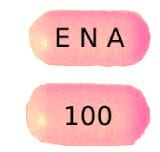Uses
Enasidenib is used to treat a certain type of acute myeloid leukemia (AML; a type of cancer that begins in the white blood cells) that has worsened or come back after treatment with other chemotherapy medications. Enasidenib is in a class of medications called an isocitrate dehydrongenase-2 (IDH2) inhibitor. It works by slowing or stopping the growth of cancer cells.
Side Effects Of Enasidenib
Enasidenib may cause side effects. Tell your doctor if any of these symptoms are severe or do not go away:
- nausea
- vomiting
- diarrhea
- decreased appetite
- change in the way things taste
Some side effects can be serious. If you experience any of these symptoms or those listed in the WARNING section, call your doctor immediately:
- yellowing of your eyes or skin
- muscle spasms or twitching; burning, prickling, or tingling feeling on the skin; irregular heartbeat; or seizures
Enasidenib may cause other side effects. Call your doctor if you have any unusual problems while taking this medication.
Warnings & Precautions
Before taking enasidenib:
- tell your doctor and pharmacist if you are allergic to enasidenib, any other medications, or any of the ingredients in enasidenib tablets. Ask your pharmacist or check the Medication Guide for a list of the ingredients.
- tell your doctor and pharmacist what prescription and nonprescription medications, vitamins, nutritional supplements, and herbal products you are taking or plan to take. Your doctor may need to change the doses of your medications or monitor you carefully for side effects.
- tell your doctor if you are pregnant, plan to become pregnant, or plan to father a child. You should not become pregnant while you are taking enasidenib. You will need to have a negative pregnancy test before you begin taking this medication. Use effective birth control during your treatment with enasidenib and for one month after your final dose. If you are a male and your partner can become pregnant, you should use effective birth control during your treatment and for one month after your final dose. Enasidenib may decrease the effectiveness of certain oral contraceptives so talk to your doctor about birth control methods that will work for you. If you or your partner become pregnant while taking enasidenib, call your doctor.
- tell your doctor if you are breastfeeding. You should not breastfeed while you are enasidenib and for one month after your final dose.
- you should know that this medication may decrease fertility in men and women. Talk to your doctor about the risks of taking enasidenib.
Enasidenib Dosage
Enasidenib comes as a tablet to take by mouth. It is usually taken once a day with or without food. Take enasidenib at around the same time every day. Follow the directions on your prescription label carefully, and ask your doctor or pharmacist to explain any part you do not understand. Take enasidenib exactly as directed. Do not take more or less of it or take it more often than prescribed by your doctor.
Swallow the tablets whole with a cup (8 ounces [240 mL]) of water; do not split, chew, or crush them.
If you vomit after taking a dose of enasidenib, take another dose as soon as possible on the same day.
Your doctor may temporarily or permanently stop your treatment, decrease your dose of enasidenib, or treat you with other medications depending on the side effects that you experience. Be sure to talk to your doctor about how you are feeling during your treatment. Do not stop taking enasidenib without talking to your doctor.
Other
Keep all appointments with your doctor and the laboratory. Your doctor will order certain lab tests to check your body’s response to enasidenib.
Do not let anyone else take your medication. Ask your pharmacist any questions you have about refilling your prescription.
It is important for you to keep a written list of all of the prescription and nonprescription (over-the-counter) medicines you are taking, as well as any products such as vitamins, minerals, or other dietary supplements. You should bring this list with you each time you visit a doctor or if you are admitted to a hospital. It is also important information to carry with you in case of emergencies.
Source
All information has been provided courtesy of MedLinePlus from the National Library of Medicine and from the FDA.



